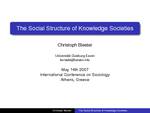Vorträge & Publikationen
- Wahrnehmung , (Steuerungs)Wirkung und Effekte von Leistungsmessung in der Wissenschaft
- Wahrnehmung und Wirkung von Leistungsmessung in der Wissenschaft
- Kritik und Lob der W-Besoldung
- Leistungsorientierte Vergütung in der Wissenschaft
- Die Einheit von Forschung und Lehre in der W-Besoldung
- Why University Governance Fails
- Der Universitäre Metabolismus
- Korrumpierung und Verdrängung?
- Der intrinsisch motivierte Professor - ein Vexierbild?
- Leistungsorientierte Vergütung in der W-Besoldung
- Governance by Objectives
- Change Management in Higher Education
- The Social Structure of Knowledge Societies
The Social Structure of Knowledge Societies
The Social Structure of Knowledge Societies, International Conference on Sociology [Athens, Greece 14. May 2007]
The basic question of how social order and human social action are possible especially during periods of social change or modernization is answered by sociology. Usually these answers are represented in catchphrases like agrarian society, industrial society, service society or knowledge society. All of these descriptions are conceptualized around the prevailing economic system of the particular society, which is regarded as a typical viewpoint of the industrial society.
From this stand point the descriptions have been created especially to emphasize the differences between industrial and agrarian societies e.g.: extent vs. small families, low vs. high geographical and social mobility, and low vs. high division of labor, in order to give a self-description of the current society. To describe the social structure of agrarian societies usually the graphical representation of an onion is used. To describe the social structure of industrial societies two different representations are used: a form that emphasizes a functional perspective like houses and a form that emphasizes opportunities, especially in terms of social mobility.
A popular description of current society is knowledge society. If this description answers the basic sociological question of social order and human social behavior in the same manner as the descriptions mentioned above, it must to be possible to identify an economic core system (1) and some categories (2) which are conceptualized around it to draw a picture of the knowledge society.

